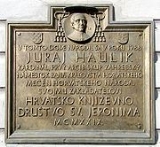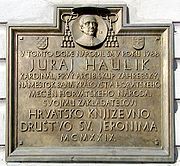
Juraj Haulik
Encyclopedia

Kingdom of Hungary
The Kingdom of Hungary comprised present-day Hungary, Slovakia and Croatia , Transylvania , Carpatho Ruthenia , Vojvodina , Burgenland , and other smaller territories surrounding present-day Hungary's borders...
, present-day Trnava
Trnava
Trnava is a city in western Slovakia, 47 km to the north-east of Bratislava, on the Trnávka river. It is the capital of a kraj and of an okres . It was the seat of a Roman Catholic archbishopric . The city has a historic center...
, Slovakia
Slovakia
The Slovak Republic is a landlocked state in Central Europe. It has a population of over five million and an area of about . Slovakia is bordered by the Czech Republic and Austria to the west, Poland to the north, Ukraine to the east and Hungary to the south...
, 20 April 1788 – Zagreb
Zagreb
Zagreb is the capital and the largest city of the Republic of Croatia. It is in the northwest of the country, along the Sava river, at the southern slopes of the Medvednica mountain. Zagreb lies at an elevation of approximately above sea level. According to the last official census, Zagreb's city...
, 11 May 1869) was a Croatia
Croatia
Croatia , officially the Republic of Croatia , is a unitary democratic parliamentary republic in Europe at the crossroads of the Mitteleuropa, the Balkans, and the Mediterranean. Its capital and largest city is Zagreb. The country is divided into 20 counties and the city of Zagreb. Croatia covers ...
n cardinal in the Roman Catholic Church
Roman Catholic Church
The Catholic Church, also known as the Roman Catholic Church, is the world's largest Christian church, with over a billion members. Led by the Pope, it defines its mission as spreading the gospel of Jesus Christ, administering the sacraments and exercising charity...
of Slovak
Slovaks
The Slovaks, Slovak people, or Slovakians are a West Slavic people that primarily inhabit Slovakia and speak the Slovak language, which is closely related to the Czech language.Most Slovaks today live within the borders of the independent Slovakia...
ethnicity and the first archbishop of Zagreb
Archdiocese of Zagreb
The Roman Catholic Archdiocese of Zagreb is the central archdiocese of the Catholic Church in Croatia, centered in the capital city Zagreb. It is the metropolitan see of Croatia, and the present archbishop is Josip Bozanić....
. He was also acting ban
Ban (title)
Ban was a title used in several states in central and south-eastern Europe between the 7th century and the 20th century.-Etymology:The word ban has entered the English language probably as a borrowing from South Slavic ban, meaning "lord, master; ruler". The Slavic word is probably borrowed from...
of Croatia for two separate terms.
He studied theology and philosophy in Trnava, Esztergom
Esztergom
Esztergom , is a city in northern Hungary, 46 km north-west of the capital Budapest. It lies in Komárom-Esztergom county, on the right bank of the river Danube, which forms the border with Slovakia there....
and Vienna
Vienna
Vienna is the capital and largest city of the Republic of Austria and one of the nine states of Austria. Vienna is Austria's primary city, with a population of about 1.723 million , and is by far the largest city in Austria, as well as its cultural, economic, and political centre...
. After the death of bishop Aleksandar Alagović in 1837, Haulik was proclaimed bishop. In 1840 he began his first term as acting ban of Croatia after the death of ban Franjo Vlašić
Franjo Vlašic
Franjo Vlašić was a Croatian general and ban.He was born April 24, 1766 in Dombóvár, Hungary. He became ban on February 10, 1832. He resisted the Magyarization of Croatia, especially the teaching of Hungarian in schools...
. He is credited for introducing the Croatian language
Croatian language
Croatian is the collective name for the standard language and dialects spoken by Croats, principally in Croatia, Bosnia and Herzegovina, the Serbian province of Vojvodina and other neighbouring countries...
into schools and workplaces, as well as forming the Matica hrvatska
Matica hrvatska
Matica hrvatska is one of the oldest Croatian cultural institutions, dating back to 1842. The name is somewhat idiosyncratic, best translated as "The Croatian Centre" . It is the largest publisher of Croatian language books...
in 1842. He helped the organization of Maksimir
Maksimir
Maksimir is one of the neighborhoods of Zagreb, Croatia. Maksimir stadium and Maksimir Park are located in it. It was named after the bishop Maksimilijan Vrhovac....
park in Zagreb.
He was succeeded as ban by the Hungarian Ferenc Haller. Haller was brought in to carry on Magyarization
Magyarization
Magyarization is a kind of assimilation or acculturation, a process by which non-Magyar elements came to adopt Magyar culture and language due to social pressure .Defiance or appeals to the Nationalities Law, met...
in Croatia, which included the banning of the then Croatian banner name: Illyrians. A protest by the Croatian People's Party
July victims
The July victims were members of the Croatian People's Party who fell victim to a crackdown by the Austrian Imperial Army on July 29, 1845.With the restoration of the Zagreb County, local elections were held around the Croatian capital Zagreb. When it was announced that the Hungarian-allied...
in 1845 was put out violently by Haller, leaving thirteen protestors dead, and ending his time as ban. Haulik was again called upon to take up the post.
During this term, the Croatian language was made official in the Kingdom of Croatia-Slavonia
Kingdom of Croatia-Slavonia
The Kingdom of Croatia-Slavonia or Croatia Slavonia was an autonomous kingdom within the Austro-Hungarian Empire. It was part of the Hungarian Kingdom within the dual Austro-Hungarian state, being within the Lands of the Crown of St. Stephen or Transleithania...
in 1847. In 1848, in the midst of revolutions in the Austro-Hungarian Empire
Revolutions of 1848 in the Habsburg areas
From March 1848 through July 1849, the Habsburg Austrian Empire was threatened by revolutionary movements. Much of the revolutionary activity was of a nationalist character: the empire, ruled from Vienna, included Austrian Germans, Hungarians, Slovenes, Poles, Czechs, Slovaks, Ruthenians,...
, military man Josip Jelačić
Josip Jelacic
Count Josip Jelačić of Bužim was the Ban of Croatia between 23 March 1848 and 19 May 1859...
was proclaimed ban to counter Hungarian aims of revoking Croatian autonomy.
Some further autonomy did materialize for Croatia in the following years, as Haulik was proclaimed the first archbishop and metropolitan of Zagreb in 1852. With this, the Catholic Church in Croatia became independent from Hungary. In 1856 he was also named cardinal. He carried on in these posts until his death in 1869.
While he was an ethnic Slovak, he said this about his background: I was born a Slovak, but I will die a Croat. In 1999, Croatia and Slovakia put out a joint-issue stamp featuring Haulik.

